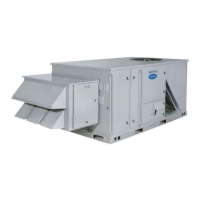62
Table 48 — IGC Board LED Alarm Codes
LEGEND NOTES:
1. There is a 3-second pause between alarm code displays.
2. If more than one alarm code exists, all applicable alarm codes will be dis-
played in numerical sequence.
3. Alarm codes on the IGC will be lost if power to the unit is interrupted.
Table 49 — Electric Heat Service Analysis
LED FLASH
CODE
DESCRIPTION
ACTION TAKEN BY
CONTROL
RESET METHOD PROBABLE CAUSE
On Normal Operation — — —
Off Hardware Failure No gas heating. — Loss of power to the IGC. Check 5 amp fuse on IGC,
power to unit, 24V circuit breaker, transformer, and wir-
ing to the IGC.
1 Flash Indoor Fan On/Off Delay
Modified
5 seconds subtracted from On
delay.
5 seconds added to Off delay
(3 min max).
Power reset. High temperature limit switch opens during heat
exchanger warm-up period before fan-on delay expires.
High temperature limit switch opens within
10 minutes of heat call (W) Off.
See Limit Switch Fault.
2 Flashes Limit Switch Fault Gas valve and igniter Off.
Indoor fan and inducer On.
Limit switch closed, or heat
call (W) Off.
High temperature limit switch is open. Check the opera-
tion of the indoor (evaporator) fan motor. Ensure that the
supply-air temperature rise is within the range on the
unit nameplate. Check wiring and limit switch operation.
3 Flashes Flame Sense Fault Indoor fan and inducer On. Flame sense normal.
Power reset for LED reset.
The IGC sensed a flame when the gas valve should be
closed. Check wiring, flame sensor, and gas valve oper-
ation.
4 Flashes Four Consecutive Limit Switch
Fault
No gas heating. Heat call (W) Off.
Power reset for LED reset.
4 consecutive limit switch faults within a single call for
heat. See Limit Switch Fault.
5 Flashes Ignition Fault No gas heating. Heat call (W) Off.
Power reset for LED reset.
Unit unsuccessfully attempted ignition for 15 minutes.
Check igniter and flame sensor electrode spacing, gaps,
etc. Check flame sense and igniter wiring. Check gas
valve operation and gas supply.
6 Flashes Induced Draft Motor Fault If heat off: no gas heating.
If heat on: gas valve Off and
inducer On.
Inducer sense normal, or
heat call (W) Off.
Inducer sense On when heat call Off, or inducer sense
Off when heat call On. Check wiring, voltage, and oper-
ation of IGC motor. Check speed sensor wiring to IGC.
7 Flashes Rollout Switch Lockout Gas valve and igniter Off.
Indoor fan and inducer On.
Power reset. Rollout switch has opened. Check gas valve operation.
Check induced-draft blower wheel is properly secured to
motor shaft.
8 Flashes Internal Control Lockout No gas heating. Power reset. IGC has sensed internal hardware or software error. If
fault is not cleared by resetting 24 v power, replace the
IGC.
9 Flashes Temporary Software Lockout No gas heating. 1 hour auto reset, or power
reset.
Electrical interference is disrupting the IGC
software.
IGC — Integrated Gas Unit Control
LED — Light-Emitting Diode
PROBLEM CAUSE REMEDY
Heat Will Not Turn On. Active alarm. Check active alarms using ComfortLink™ Scrolling Marquee.
No power to unit. Check power supply, fuses, wiring, and circuit breakers.
Unit is in minimum heat off-time, or minimum cool-heat
changeover time.
Check using ComfortLink Scrolling Marquee.
Thermostat or occupancy schedule setpoint not calling for
heating.
Check using ComfortLink Scrolling Marquee.
Heat forced off in Service Test mode. Check using ComfortLink Scrolling Marquee. Turn Service Test
mode off.
No 24 vac at heater contactor. Check transformer and circuit breaker.
Check auto-reset limit switches on heater.
Check manual-reset limit switch (LS) on heater.
Open temperature limit switch on heater. Check minimum airflow. Check limit switch when it is cool,
replace if open.
Inadequate Heating. Dirty air filters. Replace air filters.
Thermostat or occupancy schedule setpoint only calling
for W1.
Allow time for W2 to energize.
Heat undersized for load. Decrease load or increase size of heater.
Restricted airflow Remove restriction.
Too much outdoor air. Check economizer position and configuration. Adjust minimum
position.
Limit switch cycles heaters. Check rotation of blower and minimum airflow.
Bad heater elements. Power off unit and remove high voltage wires. Check resistance
of element, replace if open.
Heat Will Not Turn Off. Unit is in minimum heat on-time. Check using ComfortLink Scrolling Marquee.
Thermostat or occupancy schedule setpoint still calling for
heating.
Check using ComfortLink Scrolling Marquee.
Heat forced on in Service Test mode. Check using ComfortLink Scrolling Marquee. Turn Service Test
mode off.
Heater contactor failed. Power off unit. Check contactor and replace if closed.

